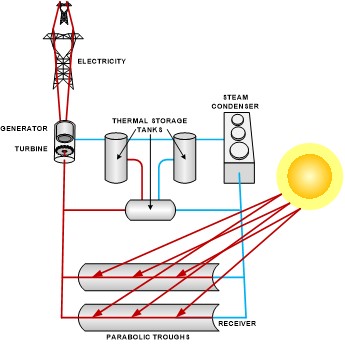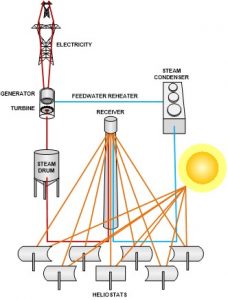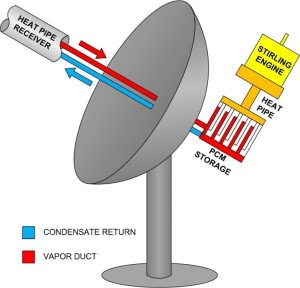
Two of the most popular forms of renewable energy are wind and solar. While nearly everyone has seen a photovoltaic solar cell on a rooftop or their pocket calculator, this blog introduces the less common form of solar power generation: solar thermal.
Linear parabolic trough collector (PTC) systems concentrate solar radiation on a fluid-carrying tube using long, mirrored, parabolic troughs. As shown in Figure 1, the troughs concentrate light onto receiver tubes suspended at the trough’s focal point. Fluid (typically oil or molten salt) is pumped through several loops to elevate its temperature. As the sun moves throughout the day, motors move the troughs to track the sun while maintaining trough’s focus. The heated fluid passes through a steam generator, transferring its heat to create superheated steam for use in a conventional Rankine cycle plant. The Solar Energy Generating System (SEGS) in the Mojave Desert, which has an electrical output of 354 MW using a PTC system.

Figure 1 – Linear Parabolic Trough Collectors
Solar towers (sometimes called “power towers”) use an array of mirrors called a heliostat to reflect solar radiation to heat a working fluid. The heliostats track the sun’s movement throughout the day to direct sunlight onto a single solar tower, which is elevated several hundred feet. The tower is normally black to minimize its reflectivity and reaches temperatures of over 1,000°F. Atop the tower, a boiler is heated to boil water to steam for use in a turbine-generator. The Ivanpah solar power tower in the California desert has an electrical output of 392 MW.

Figure 2 – Typical Solar Tower Configuration
Solar dish systems use a large, reflective parabolic dish to gather sunlight. The collected sunlight is then reflected on a thermal receiver, concentrated by the parabola of the dish. The thermal receiver contains the working fluid that cools the collector and carries the heat to the engine.
The working fluid carries the heat to the engine, typically a Stirling engine. Stirling engines use heat and a gas as a working fluid to drive a reciprocating piston, which is coupled to a generator to produce electricity. Typical outputs are much smaller than other solar thermal technologies, ranging from 10 to 25 kW.

Figure 3 – Solar Dish Engine